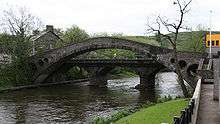Pontypridd
| Pontypridd | |
| Welsh: Pontypridd | |
 Pontypridd |
|
 Pontypridd |
|
| Population | 32,694 (2011)[1] |
|---|---|
| OS grid reference | ST075895 |
| Principal area | Rhondda Cynon Taf |
| Ceremonial county | Mid Glamorgan |
| Country | Wales |
| Sovereign state | United Kingdom |
| Post town | PONTYPRIDD |
| Postcode district | CF37 |
| Dialling code | 01443 |
| Police | South Wales |
| Fire | South Wales |
| Ambulance | Welsh |
| EU Parliament | Wales |
| UK Parliament | Pontypridd |
| Welsh Assembly | Pontypridd, South Wales Central Electoral Region |
|
|
Coordinates: 51°36′07″N 3°20′31″W / 51.602°N 3.342°W
Pontypridd /pɒntəˈpriːð/ is both a community and the county town[2] of Rhondda Cynon Taf, Wales, and is situated 12 miles/19 km north of the Welsh capital city of Cardiff. Pontypridd is often abbreviated to "Ponty" by local residents.
Geography
Pontypridd comprises the electoral wards of Cilfynydd, Glyncoch, Graig, Hawthorn, Pontypridd Town, 'Rhondda', Rhydyfelin Central/Ilan (Rhydfelen), Trallwng (Trallwn) and Treforest (Trefforest), and falls within the Welsh Assembly and UK parliamentary constituency by the same name.
The town sits at the junction of the Rhondda and Taff/Cynon valleys, where the River Rhondda flows into the Taff immediately south of the town at Ynysangharad War Memorial Park.[3] Pontypridd community had a population of approximately 32,700 according to census figures gathered in 2011.[4] while Pontypridd Town Ward itself was recorded as having a population of 2,919 also as of 2001.[5]
The town lies alongside the dual carriageway north-south A470, between Cardiff and Merthyr Tydfil. The A4054, running north and south of the town, was the former main road, and, like the A470, follows the Taff Valley. South of the town is the A473, for Llantrisant and Pencoed. To the west is the A4058, which follows the River Rhondda to Porth and the Rhondda Valley beyond.
History
The name Pontypridd is from "Pont-y-tŷ-pridd" the Welsh for "bridge by the earthen house", a reference to a succession of wooden bridges that formerly spanned the River Taff at this point.
Old Bridge
Pontypridd is noted for its Old Bridge, a stone construction across the River Taff built in 1756 by William Edwards. This was Edwards' third attempt, and, at the time of construction, was the longest single-span stone arch bridge in the world. Rising 35 feet (11 m) above the level of the river, the bridge forms a perfect segment of a circle, the chord of which is 140 feet (43 m). Notable features are the three holes of differing diameters through each end of the bridge, the purpose of which is to reduce weight. On completion, questions were soon raised as to the utility of the bridge, with the steepness of the design making it difficult to get horses and carts across. As a result, a new bridge, the Victoria Bridge, paid for by public subscription, was built adjacent to the old one in 1857. Pontypridd was known as Newbridge from shortly after the construction of the Old Bridge until the 1860s.

Coal
The history of Pontypridd is closely tied to the coal and iron industries; prior to the developments of these, Pontypridd was largely a rural backwater comprising a few farmsteads, with Treforest initially becoming the main urban settlement in the area. Sited as it is at the junction of the three valleys, it became an important location for the transportation of coal from the Rhondda and iron from Merthyr Tydfil, first via the Glamorganshire Canal, and later via the Taff Vale Railway, to the ports at Cardiff, Barry, and to Newport. Because of its role in transporting coal cargo, its railway platform is thought to have once been the longest in the world during its heyday.[6] Pontypridd was, in the second half of the 19th century, a hive of industry, and was once nicknamed the ‘Wild West’.[7] There were several collieries within the Pontypridd area itself, including:


- Albion Colliery, Cilfynydd
- Bodwenarth Colliery, Pontsionnorton
- Daren Ddu Colliery, Graigwen & Glyncoch
- Dynea Colliery, Rhydyfelen
- Gelli-whion Colliery, Graig
- Great Western/Gyfeillion Colliery, Hopkinstown
- Lan Colliery, Hopkinstown
- Newbridge Colliery, Graig
- Pen-y-rhiw Colliery, Graig
- Pontypridd/Maritime Collieries, Graig & Maesycoed
- Pwllgwaun Colliery/'Dan's Muck Hole', Pwllgwaun
- Red Ash Colliery, Cilfynydd
- Ty-Mawr Colliery, Hopkinstown & Pantygraigwen
- Typica Colliery, Hopkinstown & Pantygraigwen and
- Victoria Colliery, Maesycoed
As well as the deep-mined collieries, there were many coal levels and trial shafts dug into the hillsides overlooking the town from Cilfynydd, Graig, Graigwen, and Hafod. The Albion Colliery in the village of Cilfynydd in 1894 was the site of one of the worst explosions within the South Wales coalfield, with the death of 290 colliers (see Keir Hardie).
Iron and steel
Other instrumental industries in Pontypridd were the Brown Lenox/Newbridge Chain & Anchor Works south-east of the town, and Crawshay's Forest Iron, Steel & Tin Plate Works and the Taff Vale Iron Works, both in Treforest near the now University of South Wales.
Buildings
The town is also home to a large hospital, Dewi Sant Hospital.
Government
Pontypridd Urban District Council was established in 1894, and operated until 1974, when it was incorporated into Taff Ely Borough Council. In turn, that authority was incorporated into the unitary Rhondda Cynon Taf Council in 1995. Pontypridd Town Council continues to function as a community council. Labour is the dominant political force, and has been since the First World War.
Pontypridd community


Pontypridd community comprises the town centre itself, as well as the following key villages/settlements:
- Cilfynydd
- Coedpenmaen (Coed-Pen-Maen)
- Glyntaff (Glyn-Taff)
- Glyncoch
- Graig
- Graigwen & Pantygraigwen
- Hawthorn (Y Ddraenen-Wen)
- Hopkinstown (Trehopcyn)
- Maesycoed (Maes-y-Coed)
- Pontsionnorton (Pont Sion Norton)
- Pwllgwaun
- Rhydyfelin (Rhydfelen)
- Trallwn (Trallwng)
- Treforest (Trefforest)
- Upper Boat (Glan-Bad)
Pontypridd also serves as the postal town for the community of Llantwit Fardre under the CF38 postcode district, although this area is not considered part of Pontypridd.
Transport links
Pontypridd came into being because of transport, as it was on the drovers' route from the south Wales coast and the Bristol Channel, to Merthyr, and onwards into the hills of Brecon. Although initial expansion in the valleys occurred at Treforest due to the slower speed of the River Taff at that point, the establishment of better bridge building meant a natural flow of power to Pontypridd.
Railway

The establishment of Pontypridd over Treforest was finally confirmed with the building of the Glamorganshire Canal to serve the coal mines of the Rhondda valley. However, the volumes of coal extraction soon brought about the construction of the Taff Vale Railway, which, at its peak, resulted in a train passing through Pontypridd railway station (if one includes the freight lines immediately to its west) every two or three minutes.[8] The station was originally constructed as a long single island, at one point the world's longest platform, a reflection of both the narrow available geography of the steep valley side, as well as the need to accommodate many converging railways lines on what became the nineteenth-century hub of the valleys. Due to the restrictive geography, only parcels and mail were handled at Pontypridd, while heavy freight was handled at Treforest. The station today, as operated by Arriva Trains Wales, reflects the fewer destinations served since the Beeching and earlier cuts, with one up (valley) platform, one down (through) platform, a down bay platform (opened December 2014), and only one passing loop.
Trams, trolleybuses, and buses
A tram service began on 6 March 1905, running from Cilfynydd, through Pontypridd, to Treforest. It was replaced on 18 September 1930 by trolleybuses, which on 31 January 1957 were replaced by buses which almost exactly replicated the route. Today, bus services are principally provided by Trevor Evans (on the Newtown , Bargoed, Talbot Green and Bridgend services), and Stagecoach in South Wales (on long-distance routes to Cardiff, Rhondda, Cynon Valley, Merthyr Tydfil, Caerphilly etc.).
Education

- Pontypridd County Intermediate and Technical School was built in 1895, as a co-educational school, in Tyfica Road, later becoming Pontypridd County Grammar School for Boys. In 1973, it became the Coedylan Comprehensive School, and is now the Pontypridd High School in Cilfynydd on the west side of the A4054.
- Hawthorn High School is near the A4054 in Hawthorn (south-east of the town)
- Pontypridd Grammar School for Girls was in Glyntaff Road in Glyntaff.
- Bryn Celynnog Comprehensive School is on Penycoedcae Road in Beddau
- Cardinal Newman RC School is on Dynea Road in Rhydyfelin
- Ysgol Gyfun Garth Olwg is on the A473 in Church Village (south of the town)
- The University of South Wales is in Treforest (south of the town), next to the A473
Entertainment and social history
Sport and recreation




- Ynysangharad War Memorial Park was opened by Field Marshal Viscount Allenby on August 6, 1923. It features a bandstand, pitch-and-putt golf course, a lido swimming pool (dubbed the National Lido of Wales), tennis courts, lawn bowls greens, a football pitch, a cricket pitch, and memorials to the war dead of Pontypridd and to the composers of the Welsh national anthem. It has also hosted festivals and music concerts, including the annual Ponty's Big Weekend festival.
- Pontypridd is home to Pontypridd Rugby Football Club, one of Wales' most notable rugby union clubs, with a successful junior rugby and Age-grade sections that frequently contributes players to the national team. Formed in 1876,[9] Pontypridd RFC play in the Principality Premiership, SWALEC Cup and the British and Irish Cup.[10] Pontypridd RFC play their home games at Sardis Road, with their junior section playing at Taff Vale Park and Pontypridd High School Fields, Cilfynydd.
- Pontypridd Town A.F.C. is a Welsh football club which has achieved some success in the Welsh football league.
- Speedway racing was staged at Taff Vale Park in the town's Broadway area in 1929/1930.
- Pontypridd Bowls Club play in the top division in the Cynon Valley, Mid Glamorgan and the Cardiff League having been promoted in all 3 divisions following the 2009 season. They play their home games at Ynysanghard Park.
Media
- Pontypridd has its very own community radio station GTFM 107.9, based in Rhydyfelin near to Cardinal Newman School. It provides local news, information, and a variety of music from the fifties to the present day. It is run by a voluntary management committee.
- The Pontypridd and Llantrisant Observer is the local newspaper for the town.
- Pontypridd has a thriving digital media scene, various companies have offices here. WeeAre is a web development company that operates in the Pontypridd area.
Culture

- The Welsh national anthem ‘Hen Wlad Fy Nhadau’ (Land of my Fathers) was composed in Pontypridd by local poets/musicians Evan James and James James.
- Pontypridd was home to the eccentric Dr. William Price who performed the first mode, cremation in the United Kingdom.
- Pontypridd hosted the National Eisteddfod in 1893.
- Côr Meibion Pontypridd (Pontypridd Male Voice Choir)
- Pontypridd is home to the world renowned International Welsh Poetry Competition.
- Tom Jones, born on 7 June 1940 at 57 Kingsland Terrace, Treforest, and the world-famous son of Pontypridd frequently references his hometown in interviews.[11][12] A 65th birthday concert was held at the town's Ynysangharad Park at which he headlined.
In popular culture

- The name of the fictional Welsh town of Pontypandy, in which children's television programme Fireman Sam is situated, is a portmanteau of Pontypridd and Tonypandy.[13]
- The Welsh TV show Belonging was shot in Pontypridd
- The BBC hit sci-fi shows Doctor Who and Torchwood have filmed at various location around Pontypridd and nearby, such as at the Market Tavern pub in Market Street and the Lido in Ynysangharad Park. Other locations include at - Treforest, Hawthorn, Graigwen, Upper Boat, Trallwng, Ynysybwl, and others.
Twinning
Pontypridd is twinned with Nürtingen, Esslingen, south Germany
Initial contact between the two communities occurred in 1965, with a visit by Côr Meibion Pontypridd Welsh male voice Choir to visit a choir called "Liederkranz" based in the Oberensingen area of Nürtingen. The Liederkranz returned the visit to Pontypridd one year later. On the occasion of the next visit of Côr Meibion to Nürtingen, the partnership between the two communities was formally established - on 26 July 1968. Since then, reciprocal visits between the two choirs have taken place on a regular basis. It was as a result of this successful partnership that Pontypridd Urban District Council decided to have a formal Twinning link at a civic level, and to join in partnership with Nürtingen. In July 1968, an agreement was signed by John Cheesman J.P., mayor of Pontypridd and Karl Gonser mayor of Nürtingen. This resulted in the first twinning link in Rhondda Cynon Taf, and the longest-established twinning links with Nürtingen.[14]
Pontypridd is also twinned with Mbale, Uganda
Pontypridd town council held an official twinning ceremony in 2005, to consolidate links with Mbale, Uganda, already established by local churches and healthcare workers, under the auspices of charity PONT, the Partnerships Overseas Networking Trust.[15]
Notable people
- See Category:People from Pontypridd
- Robert James Bye, recipient of the Victoria Cross in World War I
- Opera singers, Stuart Burrows and Geraint Evans, who were both born in Cilfynydd
- John Evans, poet
- Harri Greville, rugby league footballer
- Evan James and James James, writers of Hen Wlad Fy Nhadau, the national anthem of Wales
- Tom Jones, singer of such worldwide top 40 hits as Delilah and The Green Green Grass of Home, born on 7 June 1940 at 57, Kingsland Terrace in village of Trefforest
- Elaine Morgan, scriptwriter and anthropologist
- William Price, who carried out the first cremation in the UK in modern times on Llantrisant Common.
- Freddie Welsh, world champion boxer
- Neil Jenkins, Michael Owen, Martyn Williams, Kevin Morgan, Ceri Sweeney, Gethin Jenkins, Geraint Lewis, Richard Parks, John Gwilliam and Gareth Wyatt, Welsh international rugby players
- Rock musicians Phil Campbell of Motörhead, Gareth Davies and Darran Smith ex-members of Funeral for a Friend.
- Owain Warlow, Jason Price, Ceri Hughes, Danny Canning, Richard Haig, Colin Gale and Pat Mountain, footballers
- Kimberley Nixon, actress
- Chris Slade, drummer for AC/DC and Asia
- Sheila Laxon was the first female horse trainer to win the Australian cups double, of the Caulfield Cup and Melbourne Cup
- Dr David Kelly, specialist in biological warfare, attended Pontypridd Boys’ Grammar School
- Major Sir Tasker Watkins VC, Lord Justice of Appeal, deputy Lord Chief Justice, and President of the Welsh Rugby Union was educated at Pontypridd Boys’ Grammar School
- Professional Golfer Jamie Donaldson currently the holder of Abu Dhabi and Irish open champions.
- Catrin Collier, novelist. The Ty Catrin adult education centre in Pontypridd was named in her honour in 2002.[16]
- Sir David Lloyd Jones, Judge of the High Court (QBD) (2005–12), Lord Justice of Appeal (2012- ) was educated at Pontypridd Boys' Grammar School
- Alternative metal band Lostprophets formed in Pontypridd in 1997
- Indie-folk band Climbing Trees formed in Pontypridd in 2011.
Bibliography
- Tobin, Patrick F. (1991). The Bridge and the Song, Some chapters in the story of Pontypridd. Bridgend: Mid Glamorgan County Libraries. ISBN 1-872430-05-8.
See also
References
- ↑ "Town population 2011". Retrieved 16 November 2015.
- ↑ CHK (2007-12-07). "Rhondda Cynon Taf Local Development Plan". www.cartogold.co.uk. Retrieved 2016-02-21.
- ↑ The Welsh Academy Encyclopaedia of Wales. John Davies, Nigel Jenkins, Menna Baines and Peredur Lynch (2008) pg692 ISBN 978-0-7083-1953-6
- ↑ with an urban area, incorporating nearby villages and communities, of approximately 55,000 Archived February 26, 2008, at the Wayback Machine.
- ↑ Office of National Statistics
- ↑ Williams, Huw (1981) Pontypridd: Essays on the History of an Industrial Community. University College, Department of Extra-Mural Studies.
- ↑ Ellis, Lucy (2009). Tom Jones Close Up. 0711975493
- ↑ 'Pontypridd and The Taff Vale Railway', E. Mountford, in The Railway and Industrial Heritage of Pontypridd & District p.16 (1985), Taff-Ely BC
- ↑ Fields of Praise, The Official History of the Welsh Rugby Union 1881-1981 pp26, David Smith, Gareth Williams (1980)
- ↑ "British and Irish Cup draw announced | Club News | News & Views". Ponty.net. 2013-05-13. Retrieved 2013-05-23.
- ↑ Archived November 13, 2006, at the Wayback Machine.
- ↑ "Home town welcomes back Tom Jones". BBC News. 28 May 2005. Retrieved 22 May 2010.
- ↑ "Wales - Arts - Children - Fireman Sam". BBC. 2009-02-11. Retrieved 2013-05-23.
- ↑ The History of Twinning in Rhondda Cynon Taf RCT Website
- ↑ Are Pontypridd and Rhondda Cynon Taf really twinned with places in Uganda?, PONT FAQS and PONT Background
- ↑ "Catrin Collier". ContactAnAuthor. Retrieved 2 June 2013.
External links
| Wikimedia Commons has media related to Pontypridd. |
| Wikivoyage has a travel guide for Pontypridd. |
- Pontypridd Town Council: official website of Pontypridd Town Council
- Pontypridd Town website & forum: Pontypridd Town website
- Ponty.net: Pontypridd Rugby Football Club's official website
- Pontypridd Male Voice Choir: Côr Meibion Pontypridd
- British strike - extra fodder for pit ponies, Pontypridd Photo from the Library of Congress's George Grantham Bain Collection
- Aerial photograph of Pontypridd
- The history of Pontypridd
- Pontypridd Trolleybus Pontypridd trolleybus during World War II
- International Welsh Poetry Competition International Welsh Poetry Competition based in Pontypridd
Location Grid
 |
Ynysybwl |  | ||
| PORTH | |
Aber Valley, Caerphilly | ||
| ||||
| | ||||
| Llantwit Fardre |
